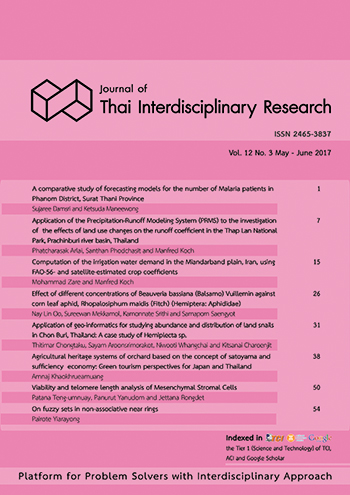Application of the Precipitation-Runoff Modeling System (PRMS) to the investigation of the effects of land use changes on the runoff coefficient in the Thap Lan National Park, Prachinburi river basin, Thailand
Main Article Content
Abstract
Thap Lan National Park (TLNP) and it’s vicinities are located in the northern part of the Prajin River basin and are a famous tourist spot, as they are not too far from Bangkok, not to the least due to the beautiful mountainous scenery and the cool weather in the winter time. Unfortunately, as a caveat to this increased tourist attraction, the tourism service sector in TLNP has been steadily expanded in recent years, with partly illegal deforestation, intrusion and build-up of resorts and/or hotels. Thus, land use in that area has changed to a certain degree. Moreover, as this part of the TLNP, because of its hill-slope topography, acts as a recharge area for the Prajin River basin, the hydrology of the latter may have been affected as well. One parameter to quantify the hydrological consequences of these land-use changes in the TLNP is the runoff- coefficient (C). For its computation the PRMS-model was set up for the whole Prachinburi River basin and calibrated with meteorological and discharge data for the time period 1993–2012 and the recent land-use. The results show that PRMS has an acceptable performance in simulating the monthly runoff in the study area and, consequently, also the runoff-coefficient in the TLNP area, which on annual average, turns out to be C = 0.21 for the time period considered. Starting from this base scenario, and extrapolating the above-mentioned land-use change in the TLNP to some extreme deforestation, PRMS was applied again to simulate the ensuing hydrological effects. A change of C from C = 0.21 to C = 0.28 is obtained, i.e. an increase of the average annual runoff by 33%. For some months of the year, namely, at the end of the dry season in late spring, the runoff for this adverse scenario is augmented by an even higher rate of more than 100%. All these run-off increases go, obviously, hand in hand with corresponding decreases of the groundwater recharge of the basin which indicates that its hydrological water budget would be significantly altered by such extreme land-use changes in the TLNP area.


